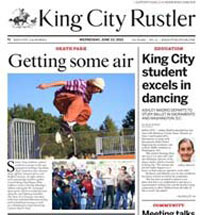I received an email from a fellow who lives out Jolon way, in which I was asked about a situation I had never really considered and I found that I was probably too close to the subject to have ever had the notion enter my thinking.
What Curtis, his name is Curtis, had noticed one day on a drive northward on the 101 that there was no recreational use of the Salinas River. No kayaks, canoes, no motorboats, no air-filled floatation devices, be they store-bought or a patched tractor tire inner tube, and no people neither swimming nor wading. He was aware that access to the river is dependent upon permission from landowners, but still the absence of any type of recreation was noticeable.
I thought about my past experiences and felt I could address some of Curtis’ remarks, but as for any legal restrictions regarding the river I had no clue, so I set upon some research and as usual lost about half an hour perusing a couple sites; interesting river we have flowing past us. Here are just a couple little factoids:
Probably the oldest and first name of the river came from the Rumsen, a coastal people of the Upper Salinas Valley, who called it “ua kot taiauacorx;” don’t ask me to pronounce it, even phonetically. The Salinas River headwaters in northern San Luis Obispo County and flows northward for 175 miles, where it empties into Monterey Bay near Spreckels. The river is fed by four major tributary rivers, the Estrella, Nacimiento, San Antonio and Arroyo Seco, and numerous creeks, including Paso Robles, Jack, Atascadero, Santa Margarita, Trout and our own San Lorenzo. The only dam on the river forms the Santa Margarita Lake. There is much more historical and geographical information about the river, it really can be both informative and entertaining; I recommend it.
As for the legal aspect of Salinas River use, the law is cited in the California case “People vs. Mack” with this: “Members of the public have the right to navigate and to exercise the incidents of navigation in a lawful manner at any point below high-water mark on water of this state which are capable of being navigated by oar or motor propelled small craft.” What comes into play here is the wording of this right to navigation when applied to individual rivers. After the high-water season for any of the tributaries, it is usually easy enough to tell the high-water mark because of the narrowness of the channels and the foliage near the banks. Not so easy with a river running through a wide, flat plain as the Salinas does. And which rivers are “capable of being navigated”? It seems it left to the individual’s determination as to whether their vessel is capable of floating without undue interruption and any cohorts can safely handle the water. And this is where I get to offer my wee bit of experience with what has been called “the upside-down river.”
When still living on Fifth Street in Greenfield, so prior to 1963, there were two boys on the block whose grandfather would regularly take his small dog, a beagle of some sort, down to the Salinas River and park on Elm Avenue just past the bridge over the river, and however many of us neighborhood boys had piled into the car then piled out of the car and scurried around the riverbed from banks to Metz Road. I can recall playing soldiers and crawling leatherneck-style through the brush while grandpa waited for the pooch to return from his, or her, frolic through the same brush.
A few years later we fashioned homemade spears out of broom or mop handles and drill bits, not making either mothers or fathers very happy, and made the numerous suckers and carp our targets and later still it was .22 cal. rifles or shotguns when we would shoot anything that would run, fly, swim or sh…poop. I have also written about the time three of us Greenfield-brain children decided to take a boat ride from south of King City to Greenfield during the floods of 1972 setting off from an Oasis Road ranch. We capsized not more that a half-mile downriver from where we started, lost some valuables, and finally wrestled the boat to the bank at the 101 southbound bridge. Not a wise choice of entertainment.
The rivers which feed into the Salinas River flow down from the mountain ranges through rocky, steep sided canyons where there are numerous deep holes with either an outcropping of rock to dive from or a car tire tied to a rope hung from a tree where one could swing out over the water and let go. There are narrowed areas where the flow reaches rapids speed, and in the upper reaches there is fishing and in some places one can still find the occasional crawdad. None of this exists in those parts of the Salinas River that I know. Rarely is there a hole deeper than one’s knees and given the width of the flood plain the flow is very slow.
In all my years I have never come across a rock anywhere in the river. It is just not that kind of a river. It is a crop-growing river with little recreational value. Pedaling into San Lorenzo Park, I have occasionally seen some younger boys with either older brothers or uncles or fathers wading in the part of the river just south of the northbound 101 bridge, but beyond that the river through our part of the Valley is empty of humans.
I hope that sheds a little light on the subject. And if, like Curtis, you have any comments or questions just shoot me an email and I’ll address them as best I can. This is the first week of a new summer and I hope it is a good one for all.
Take care. Peace.















Federal water law applicable to navigable waters in the west has been upended by several political (Republican dominanted) Supreme Court decisions of the past 5 years. In our subdivision, a segment of the Nacimiento passes through a number of parcels, all of which claim, ignorantly, ownership of both land and water within the bed and bank of the Nacimiento above the reservoir and have harassed and shot at recreational users and otherwise discouraged legal use through bullying behavior.
Likewise, The Salinas River is subjected to similar public ignorance-based or super-private interpretations of law which effectively result in a prohibition to use. Unlike the upper Nacimiento and San Antonio watersheds, the Salinas, whose flow is a product of the two headwaters upstream reservoirs releasing water during dry seaons, is broadly polluted with fungicides, herbicides, growth hormones, GMO byproducts, mercury and waste by products from the extensive Chevron water injection fields in lower South County.
Large and small private land-owners along the river are often hostile and claim ownership over water and land, which is incorrect of course, and is a legal fiction. Bank to bank, federal waters of the US and the Salinas (flows created by the San Antonio-Nacimiento headwaters) are protected still, to some degree, by federal law and are open to recreational use. Getting across private land to use the water however, is the rub.
Most farmers know and ignore the rights of recreational users, and the police locally are basically equally uninformed about use rights along the Salinas. The County has closed down some popular swimming areas downstream from the Nacimiento Reservoir by eliminating parking access, and failing to provide for any such access even in places where the river passes near Highway 101 or County (G designated) roads.
Since much of the water is polluted by agricultural runoff and other sources such as landfill mines, cement (lime and shale harvesting), and sediment producing rock and sand operations, often in mercury and arsnic laden formations, it is probably for the best that there is minimal human use of the Salinas drainage. Note also that all the small cities along the Salinas inject treated wastewater into the Salinas. River contributing substantially to daily flows Not a great river for inner tubing or having a lot of skin or mouth contact except in the fast moving periods of high winter water, which has its own risks.
Interesting observations you make, but there is an explanation.
If you live here, you know the only clean water is in land held in trust for the people by Fort Hunter Liggett (about 240,000 acres) and the wilderness areas of the Monterey District (250,000 acres). Here you will find modest recreational use of upland waters in mountain areas, not in the low-lying aglands of the Pleistocene age of the Salinas River banks,.